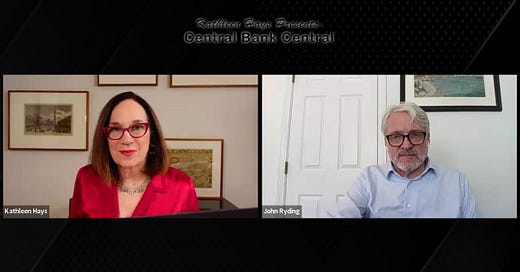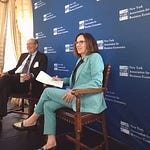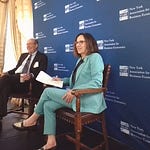John Ryding has spent decades analysing macroeconomic forces and their impact on central bank policy. He started his career at the Bank of England, worked as at the Federal Reserve Bank of New York, and then spent 17 years at Bear Stearns as its chief economist until its failure led him to strike out his on own and found RDQ Economics where he is founder and chief economist as well as now advisor to Brean Capital.
So he has ridden many business cycles, many monetary policy waves in his time which takes me to our conversation after the U.S. Consumer Price Index. What does he see now as the world waits to see what President Trump does next with tariffs and the Fed waits and sees to when it should cut rates again?
Number one, inflation is aleady rising again even as it looks like the tariffs imposed until now are far from having worked their way fully into the price level. As John says “if you're looking for evidence of tariffs at this point on inflation, you're generally not going to find them because you wouldn't expect to see them because most of the goods that are being sold right now are probably still inventory that's accumulated pretax.”
He also explains how the theory of “menu costs” may be holding back firms’ readiness to hike prices. And the fact that “in the short run… companies are under a lot of political pressure not to raise prices <as> we’ve seen some very pointed commentary against price increases coming from the Administration.”
Dive in and hear what John has to say about the factors determining the Fed’s policy path just in time for the July policy meeting.
Inflation and Fed policy- Recall that the Fed cut rates less than a year ago 00:02:04:07
First we have to remember - and I think it's a little forgotten in some of the discussions - that the Fed actually cut interest rates by a percentage point between September and December of last year. There is some policy easing still out there working through the system. One of my favorite quotes from Milton Friedman. “Inflation is always and everywhere, a monetary phenomenon.” That perspective is also a little lost these days.
Inventories buy firms time on pricing decisions 00:02:47:01
But, in terms of what we have, we've got inflation that is edging up a little bit. Could be noise, but we have the main impact of tariffs yet to be felt and we shouldn't have expected to feel them at this point just because of the amount of inventory that companies have on hand. So companies built up inventories already, and had quite a bit of inventory ahead of the April 2nd Liberation Tariff Day announcements. Much of what is still being sold is ‘pre-tariffs inventory.’ At this point, with inflation edging up, with the bulk of the tariff effects, whatever they are, to feed through. And last week St Louis Fed president Musalem said we don't expect to see <impact yet>. He doesn't expect it until the fourth quarter of this year, the first quarter of next year.
Inflation is not now accommodating for rate cuts 00:03:43:20
So right now, inflation, which is one of the Fed’s two jobs: to keep inflation under control is not exactly flashing a red warning. But it's certainly not flashing a green light either, and certainly not greenlighting a rate cut at the July meeting or even possibly not even at the September meeting.
Policy is ‘wait and see’ with two exceptions 00:05:04:06
Powell would say we're ignoring all that stuff and we're just focusing on our job. And the message, with the exception of the two Fed governors who were appointed by President Trump, (Governor Waller and Governor Bowman), from everyone else, seems to be we've got to wait and see.
Fed policy is more than just a Chair; Independence matters 00:05:28:06
So even, if <Trump> were to triumph <in some way> possibly, which I don't imagine he's going to do… < to bend or replace Powell> even if he were to do that, he would still have to get the backing of the majority of the committee. So it's not just a Chair Powell decision. And even if one were to replace the Chair - if one could magically wave a wand and have a new Fed chair in place - that person, he or she, would still have to carry the majority of the committee. I think it makes the Fed's job harder. It certainly doesn't make the Fed's job easier. But what it does do, I think, is create an environment where the Fed's independence may be perceived as being under threat. And it is really that independence that helps anchor longer term interest rates and keeps inflation expectations down.
Eroding Fed independence could prove very costly and untimely 00:06:27:10
<Independence under siege> really changes, I think, how the Fed's actions might be perceived or whether even if Powell, as I suspect, will be able to stay until May of next year, when his replacement comes in, and that person seeks to cut interest rates pretty quickly. That has been something of a litmus test that the president has suggested that his nominee would have to meet. The Fed's independence is going to be perceived as being under threat. The Fed's inflation fighting credentials are going to be questioned. And at that point, we're going to be feeling the bulk of the tariff impact on prices, whatever they are. And there’s the risk is that a one-time shock to prices from higher taxes, from higher tariffs feeds into inflation expectations.
So far so good then…Anchors aweigh? 00:07:24:03
And that's really what the Fed has done a remarkable job in doing, is through all of this, keeping inflation expectations relatively well-anchored. They are very well anchored in the marketplace. They're somewhat less well anchored amongst consumers. Yeah, particularly the University of Michigan, which is signaling sort of 4% inflation outlook over the next few years.
The NY Fed survey today showed building price pressures 00:09:55:14
What we did see in the report, the New York Fed released on manufacturing conditions that came out alongside the CPI, is that you have a lot of firms paying higher prices for inputs. 78% of firms were paying higher prices for inputs. Simply put it, and that is the so-called diffusion index 78% of firms are paying higher prices.
That's a very high percentage. And the percentage of firms receiving higher prices was over 20%. The net percentage of higher prices versus the percentage lower was over 20% for the fifth month in a row. And just to give you a comparison, back in 2019, when no one viewed inflation is a problem, the net percentage of firms experiencing high prices in manufacturing was about 10%.
Proportion of fast-rising prices in services is expanding 00:10:56:15
So we have that and there's another thing that and it's an indicator that we follow, which is the percent of commodities and services within the CPI detail, commodity and services that are rising at a rate faster than 5% and that has been climbing for several months and it's getting close to almost half the categories of the CPI rising at a 5% or faster rate. We have … this view that if the breadth of price increases is expanding so more and more firms are more and more industries, more and more commodities are rising at a faster rate, that that is something more indicative of an inflation problem. Whereas if, let's say the CPI was being driven up because rents were rising quickly, that might indicate a shortage in housing but be less of an overall monetary problem. But actually the housing segment, which has been a persistent contributor, has been diminishing in importance, but the inflation numbers have been edging up. And it's really this breadth of price increases that might suggest that we are seeing something of a rising inflation pressure.
Inflation exists-not predominately tariffs…Yet 00:13:12:14
But it's not at this point predominantly tariffs. And that is something of a concern because we know that's out there. We know that the government is raising at an annualized rate over $300 billion a year in revenues from these higher tariffs. We haven't seen input prices defined yet. So those are being paid by somebody at this stage. It's not really the consumer.
Menu costs and the desire for infrequent price changes 00:16:29:01
So maybe <companies> don't want to raise the prices too frequently if consumers are going to have a negative reaction every time firms raise prices. Then, maybe, they want to know what the final impact is going to be <before they raise their price>. And of course, we've no idea what tariff rates are going to be. August 1st is still a little over two weeks away and comes two days after the Fed meeting. In the short run companies are under a lot of political pressure not to raise prices, we've seen some very pointed verbal commentary against price increases coming from the Administration. And so companies have relatively wide profit margins. For a period of time until they see where the dust settles, I mean, imagine if they were to pass through all of the tariffs and then finally the tariff rates come in lower than expected, which would be nice. Then they may have taken a hostile reaction from the consumers and have no need to have done it. So in the short, okay, not only are companies selling out of inventory and paying higher tariffs, but those higher tariffs are probably going to eat into profit margins. Maybe we'll see that there's some bearing of those costs falling on foreign manufacturers? There's no evidence of that in the data through May at this point. But all right. There are various stories about foreign manufacturers. So that's the $100 billion plus increase in taxes (tariffs) that has to be paid by somebody.
Tariff revenues up sharply but not prices…for how much longer? 00:18:57:07
I said I think companies, first of all, need clarity on what the final tariff rates are going to be before they make decisions. Secondly, as I said, companies have a large margin to absorb the increases in the short term. And in some ways those increases are really we bought this inventory several months ago. There are no tariffs on the goods in inventories firms are selling now. Yes, there will be, in the goods that will replace them at higher prices because of the tariffs. And then firms have got to make decisions about down the road what they're going to sell. Now in terms of how much inventory is on hand, we calculate that on average there is about 3.7 months of inventory or 3.8 months of inventory in relation to sales.
Tariffs and markets 00:20:41:18
Right now, markets seem to be in a little bit of tariff fatigue. One story is that markets have moved on from tariffs. Markets may have moved on from tariffs. The economy hasn't even really fully embraced the impact of tariffs. So, you know, I think there are still, you know, challenges to be navigated out there.
The labor market loses dynamism, more than it loosens up 00:21:52:21
Well, before we dive into how the Fed may characterize the labor market a little bit, I mean, you know, right now the unemployment rate's 4.1% and that's around what the Fed thinks is full employment. Too many Fed officials said the economy's at full employment. But what's happened so far is that the dynamism of the labor market has diminished. There's very little evidence that companies in total, obviously there's always individual stories, but very little evidence in total that companies are laying off workers at a faster rate. The layoff rate is still pretty low. But the other side of that coin is that companies are not hiring at a very dynamic rate either. So, you know, if you're one of the unfortunate people who do lose their jobs, then the time you're maybe out of work may be longer than it has been recently. Nevertheless, in total, if we look at the number of jobs that companies haven't been able to or have chosen not to fill, but they're still advertising for those jobs versus the number of people who are looking for jobs, You're still in a position where there's slightly more jobs available than there are people looking for them. So overall, the labor market is in a pretty healthy place.
The Fed’s dueling mandate: description Vs action 00:25:40:01
What do you do if inflation is above target and the unemployment rate is above target too? Well then the Fed has said we look at which wants further from target without telling us how quite how we compare them. And then we focus more on that. Well, right now inflation is still clearly above target. Um, the core CPI is 2.9%. An inflation target in CPI terms might be two and a quarter percent. So soft target drifting a little bit away from Target and the impact of tariffs to come, whatever that impact is. As far as I was concerned, the unemployment rate is at Fed's estimate of full employment as there are plenty of job vacancies relative to job seekers. Okay, so that that is not something that ought to be pressing. And if the argument is, well, the Fed should take out more precautions against a potential unemployment problem ahead, then why isn't the argument that the Fed should be taking even more precautions about an inflation problem that could be out there?
Wait and see is the right policy for now 00:26:46:24
I think the Fed is watching and waiting and most policymakers have signaled that's where they are; that is doing the responsible thing. That's not hiking rates ahead of potential problems in the economy because of where inflation currently is. But it's not cutting rates and feeding the problem. The lesson of 2021 is that we should be clear, the Fed waited too long to lean against the inflation pressures and that Fed the rise in inflation. Going back to where I started our chat, you know, Milton Friedman's famous quote, Inflation is always and everywhere, a monetary phenomenon. You know, if you follow another, uh, think of a monetary Hippocratic oath, do no harm coming out of that. You would just sit. And I think that's where the majority of the committee, the vast majority of the committee currently stands <or sits!> .
John Ryding
John Ryding is the Chief Economist and a founding partner of RDQ Economics.
John was at Bear Stearns from 1991 to 2008 (most recently as the Chief U.S. Economist) where he was responsible for analyzing and forecasting U.S. economic trends and monetary policy. John has considerable experience in global central banking and monetary policy. Prior to joining Bear Stearns, he was a Senior Economist at the New York Fed from 1989 to 1991 and an Economic Advisor to the Bank of England, where he worked from 1980 to 1989.
John graduated with a BA in Economics in 1980 from Sidney Sussex College, Cambridge, England.













Share this post